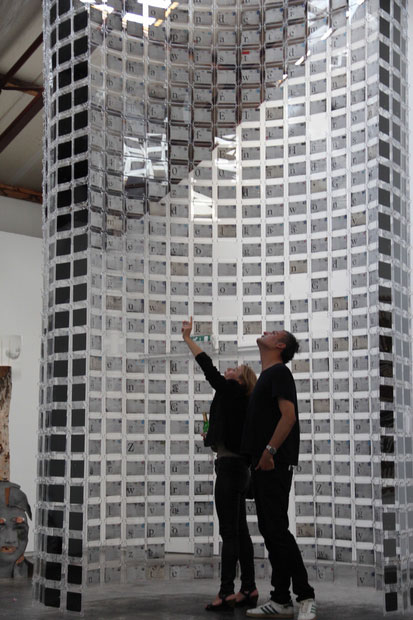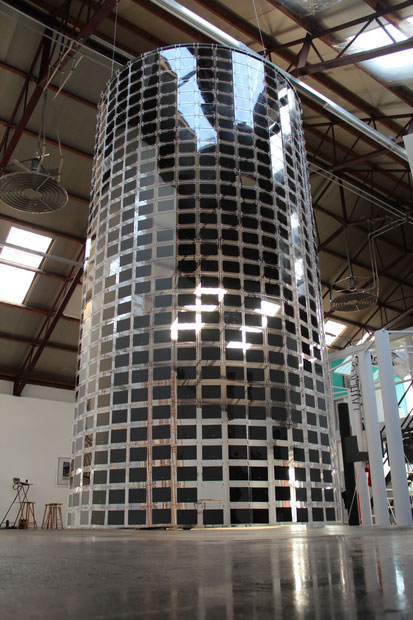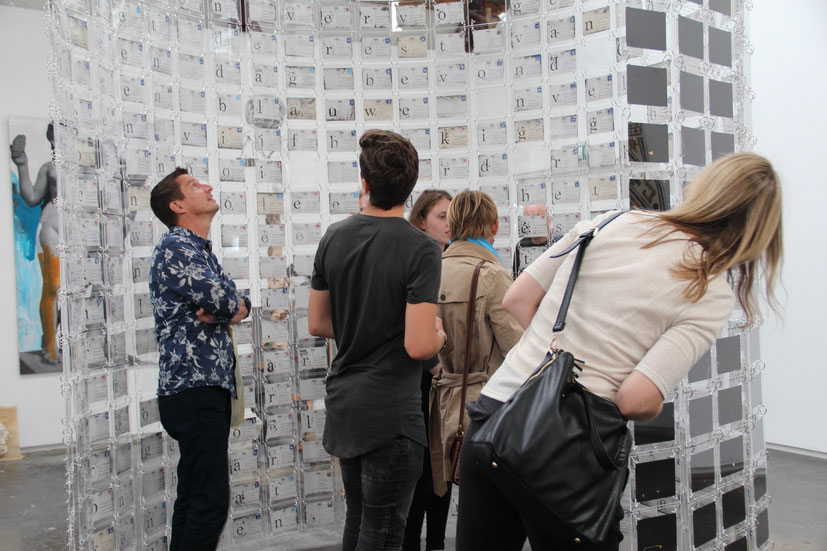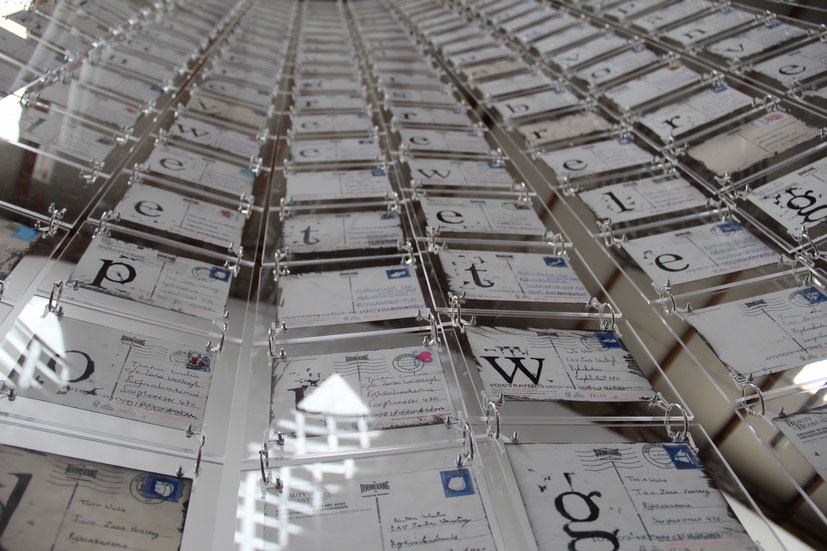“There was once a girl called Gretel. She lived in Amsterdam, right on top Hansel’s apartment. Gretel didn’t know it, but like her, Hansel also worked as a subcontractor deliverer for the postal service.
One day, Gretel found herself holding a blue envelope in front of a pentagonal building she had never seen before …”
40,000 Homes and a Sense of Security is an installation of 900 prepared postcards that were sent through the privatised Dutch postal system from around the Netherlands to Rijksakademie, Amsterdam, where Wulia was based for a short residency. The postcards were originally free postcards used for advertising, spraypainted shiny black for the work. Each postcard has a character stamped on their message side, and all 900 makes up a story (in Dutch) about the present-day Hansel and Gretel who – like many people in the Netherlands – work as subcontractor deliverers for PostNL, the first privatised postal system in Europe.
A few of the postcards never reached the destination. As planned, Wulia processed the ones she received with cyanoacrylate fuming technique to reveal the traces of fingerprints they pick up along the way. The postcards then were framed and linked together to make up a tall cylindrical installation. The full story, minus a few characters, can be read from inside the structure. Reading the story from beginning to end, the visitors’ head will move in a way that might give them a kind of motion-sickness.
ABOUT THE WORK
From the Office to the Homes
The snail mail industry is arguably dying. In Canada, between 2012 and 2011 alone, snail mails declined as much as 255 million in number. Even the US Postal Service, known as the most efficient postal service in the world, is struggling – in 2013 they had to eliminate Saturday delivery of letters to save $2 billion annually. In a press release in 2015, the Dutch postal service PostNL approximated having 56,000 employers – in 2016, their website stated approximately 40,000. This decline is intriguing because mail used to be quite central to the idea of a country. In many remote areas around the world, the post office is often the only government office in town. Before internet, postal routes were crucial to connect citizens separated by distance across a country. Messages could be sent through other means – telegrams, telephone and fax machines, for example – however objects, or things, needed to go through the post.
In an attempt to solve problems resulted from the decline, there is a trend of privatisation of public services especially in the first world in recent years. The Dutch post especially has been a frustrating case of postal service privatisation, one that is referred to in debates against privatisation in the rest of Europe and the Americas. A part of a privatisation process means more subcontracting with low pay, and subcontractors often ended up having to sort mails within their own homes. Amongst the current 40,000 employers of PostNL are the subcontracted deliverers who would go on a daily round to dispatch our mails, riding their own bicycles. They might be our own neighbours.
From Connecting to Watching
Postal service was evidently one of the few public services where central governments touch everyday lives of almost every single citizen on a daily basis, reasonably aiding the formation of a nation. Throughout history the postal service has been instrumental in this – the Roman Empire used its messenger routes to ‘knit’ its empire, and its postal routes were utilised as military infrastructure. Despite the word “post” in its name, de Grote Postweg, built in Java during Daendels’ rule as a governor-general of East Indies, was mainly used for transportation and logistics intended for militaristic purposes.
Regardless of the rapid decline, the ever-presence of postal services is as of yet still actual. While PostNL plans to cut down the number of postboxes from 19,000 to 10,000 in the next few years, they are also aware of the fact that with their deliverers, they are still present in every street in the Netherlands, every day. Thus, in its struggle to find new niche in a world that is quickly becoming virtual, they brought up a thoughtprovoking pilot in Schiedam in 2015. In this pilot, their mail deliverers would observe such things as graffiti and litter in public spaces, and report this to the municipality.
Merely a Sense of Security
Fingerprinting, a technique I will use in this work, has an aura of misconduct around it. Although it is scientifically proven that little children’s fingerprints would not be imprinted for too long because of the different type of sebum that they carry, angry mothers who regularly need to clean up windows dirtied by their five year-olds might argue otherwise. On the other hand, for many, fingerprinting is like having your mugshot taken after you have been arrested by the police. It is demeaning. When I applied for the Schengen visa, however, I had to agree to a fingerprinting request. Without any accompanying explanation, I just assumed that by agreeing, I was helping the world’s judicial system to ensure security. But how far does fingerprinting really protect or harm us?
Personal Judgement and Homeland Security
The process of revealing latent fingerprints is similar to the process of developing the latent image on a film negative. However, the results are much less immediately recognisable than actual photographs of people’s faces or figures. Fingerprints, even when they are revealed, can only be identified within a system that is inaccessible to most of the society. This identification process is called dactyloscopy.
Despite the general public’s belief that dactyloscopy is infallible, it is actually a questionable technique in criminology. The infamous case of Brandon Mayfield, the American attorney who was identified through his fingerprint as a participant in the 2004 Madrid bombing, is only one of many that shows how personal judgement can influence inaccuracy of dactyloscopy. In Mayfield’s case, his personal background misleadingly affect FBI’s reading of his fingerprints as an “absolutely incontrovertible match” amongst 20 candidates. Mayfield is a convert to Islam after his marriage with his Egyptian wife. This fact, which should have not been a factor in dactyloscopy, nevertheless made his identification conclusive – until it was contested, after the two weeks he spent in prison. Mayfield’s competency in law might have been decisive in making his case highly visible through the lawsuit he pursued; there might have been other cases that remained unnoticed.
My Work
In 40,000 Homes and a Sense of Security I will disclose the traces of these diminishing postal routes that physically connect the globalising governments with me, in person, where things travel in between, going from hand to hand in the process, perhaps sorted in the deliverers’ homes, all the way to my own temporary home in Amsterdam.
A thing I send to myself through PostNL will go through so many individuals in between – including people who operates the sorting machines – yet when they come to me they appear intact, as part of the post office’s standard of high quality service. I plan to make these connection between so many people – unique individuals – along the routes visible through techniques that reveal latent fingerprint and other marks.




